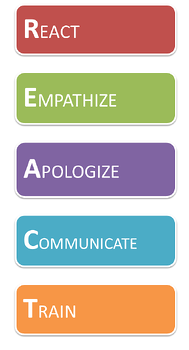
I returned recently from a cruise where so many mistakes were made, I decided to revisit this topic. Mistakes are to be expected, I get that, but knowing how to recover an angry or frustrated customer into a loyal customer is a learned art. A Customer Focused Attitude is critical for successful service recovery. Employees need to be trained to anticipate and identify potential problems, as well as have the experience to make decisions and to deliver skillful solutions to customer problems.
All customer problems are opportunities to win over their loyalty. Most of us know that 80% of dissatisfied customers tell 10 people and ~20% of dissatisfied customers tell 20 people? You don't want this negative publicity! So as soon as it is apparent that your customer is upset or that there is a problem, it is absolutely necessary to deal with the situation ASAP. Attention and awareness can eliminate most issues.
Knowing how important service recovery is, we put together our proven 5 step training resource, REACT, that promotes better understanding, polished communication skills, and fosters creative thinking needed for successful problem resolution. Help your associates master these 5 Steps.
React: Successful problem resolution is all about the speed in which you react to the situation. Set aside all other tasks and tend to your customers problem. You may not always have the solutions, but a quick and timely reaction will neutralize the emotion in the situation far quicker than waiting.
Empathize: Showing empathy is a structured communication skill and not just a feeling. You need to demonstrate acceptance of their feelings, this makes empathy genuine. Acknowledging another's emotion by asking questions such as: "I can see you are really uncomfortable about this." Or, "I can understand why you would be upset."
Apologize: Apologize by taking ownership, being professional and honest, which will build trust. Regardless whose fault, apologize for the "situation," recognizing the frustration to your customer.
Communicate: Over communicate during problem resolution to avoid misinterpretations of the situation. Communicating effectively means to not blame, pass the buck, or over-explain. Ensure that your voice tone and body language is consistent with your words. Otherwise, your words will be of little significance.
Train: Train to prevent the issue from happening again. Train your associates to anticipate your customers' needs and respond to those needs in a timely manner, as well as deliver the unexpected. Learn from the problems your customers experience and be glad they have given you the opportunity to become better.
If you are interested in improving your problem resolution processes, or making memorable customer experiences, let us help you make a noticeable difference.


